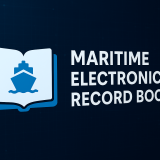Danish ship repair specialist Orskov recently held a ceremony to open its extended repair facilities in Frederikshavn.
The new 25,000m² yard area was officially inaugurated by Orskov Yard and Port of Frederikshavn. The area comprises of Dock 5 and Jeppe Ørskov Pier. In addition, Arne Ørskov Vej, which is the main road on the new port expansion was also officially inaugurated by the 200 invited guests.
Arne Ørskov Christensen founded the yard in 1958, since then Niels Ørskov took over the management and operated the activities at Port of Frederikshavn. In 2003, 3rd generation stepped in with Christina and Jeppe Ørskov at the rudder, and the yard changed direction from a newbuilding yard to a ship repair yard. It was the beginning of a new era for the family-owned company.
At the ceremony Niels Ørskov was in charge of the official inauguration of Arne Ørskovs Vej and Malte Ørskov opened the Jeppe Ørskov Pier, named after his father.
“We pay tribute to Arne and Jeppe with street name and pier name. We have officially inaugurated Dock 5, which is another milestone not only in the story but in the reality of Orskov Yard. Nothing could be possible without the Ørskov family. Everyone with their own personality, but all with the same drive. All what we value – we want the best for this town, we want to survive, we want to grow,” said Fredrikshavn Mayor Birgit Hansen.
“The entire family is very honoured that Port of Frederikshavn and the Municipality in Frederikshavn chose to name the newly established main road on the port expansion Arne Ørskovs Vej. After all, he is the original reason why we are where we are. Likewise, we have had the great honour of having the newly established pier named Jeppe Ørskov Pier. Jeppe was very dedicated to the port expansion becoming a reality and thereby gaining growth to the yard and the town”, said Director and Owner Christina Ørskov and Chairman Niels Ørskov.
The new floating dock – Dock 5 – arrived in Frederikshavn in August last year and was named on January 15, 2021 by Jeppe’s daughter Luna at a private ceremony due to Covid-19, and now the quay area is finished.
“It is really a joyful day today. We have worked on this project for many years and now we have a new floating dock and a new beautiful quay area. The road has been exciting and challenging. Ever since we made the first drawings until we travelled around the world to look at potential docks, until we signed the contract with the Turkish yard Hat-San on a new built floating dock, signed the contract with Port of Frederikshavn, got the authority project in place and until the building of the dock in Turkey and the construction of the quay area here in Frederikshavn,” said Lars Fischer, CEO Orskov Yard.
Since Dock 5 was taken into use in January this year, 11 vessels have been docked and it has only been idle for 10 days. On average it has employed 100 full time positions a day, this in addition to the existing activities at Orskov Yard. Dock 5 has, with its size and draught, shown its worth and Orskov Yard now has the possibility of rendering service to large vessels, which otherwise were obliged to choose another yard. In addition to the new floating dock and the new quay area, a new machine and pipe workshop will be built, which will be finished by the end of the year.
“Jeppe was a great driving force with regards to the port expansion and he expressed that “we have to develop Port of Frederikshavn, otherwise we will close down activities”. Today we see some of the results – and Dock 5 has a great symbolic significance. Ørskov took an initiative as engine and has taken responsibility with a great investment, which will benefit the maritime service industry in the entire Northern Jutland,” said Mikkel Seedorff Sørensen, CEO Port of Frederikshavn.
Orskov is planning further expansion with an even larger dock featuring in the plans.









